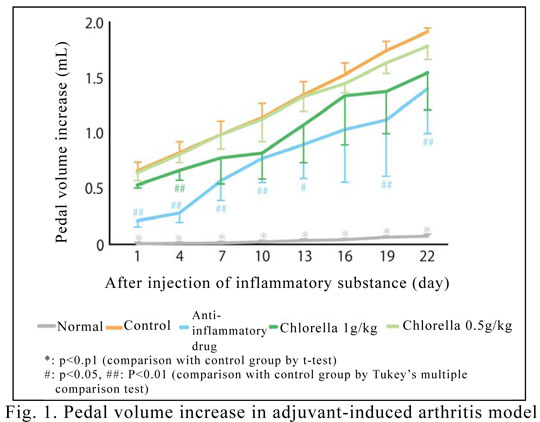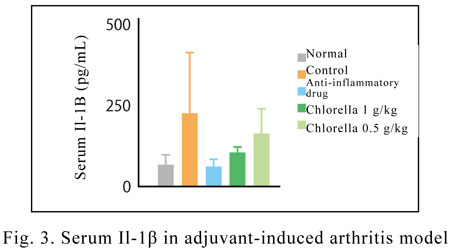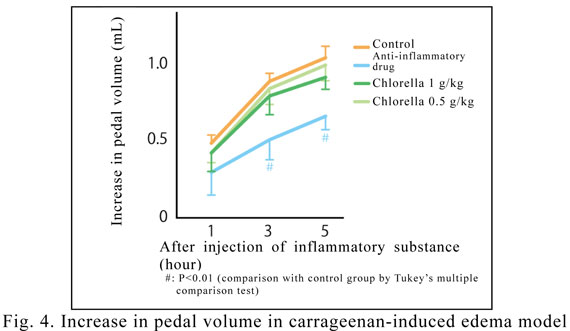- TOP
- List of reports
- Anti-inflammatory effects of chlorella in chronic and acute inflammation
Anti-inflammatory effects of chlorella in chronic and acute inflammation
【Scientific information】
Research and Development Department, Sun Chlorella Corporation
Anti-inflammatory effects of chlorella in chronic and acute inflammation
Presented at the Annual Meeting of Japan Society for Bioscience, Biotechnology, and Agrochemistry (JSBBA) 2009 in Fukuoka
- Study Objectives
- Inflammation is originally related to biological defenses against microorganisms, etc. However, inflammatory reactions that have become chronic are known to be involved in rheumatism, etc. We have elucidated in vitro possible anti-inflammatory effects of chlorella. (For details, please refer to "Investigation of pharmacological effects of chlorella powder" (reported at the 61st Meeting of the Japanese Society of Nutrition and Food Science). In this regard, we verified the anti-inflammatory effects of chlorella in using 2 animal models, including one with chronic inflammation in adjuvant-induced arthritis and the other with acute inflammation in the form of carrageenan-induced edema.
1.Adjuvant-induced arthritis model*1
- Method and experiments
- Rats were assigned to the following 5 groups, and the degree of pedal volume increase induced by adjuvant was compared among groups given chlorella powder for 28 days and a group given anti-inflammatory drug. On the last day of the study, the degree of ankle destruction was assessed*2 and serum cytokine 1L-1β*3 levels were determined.
1)
Control group: Only an inflammatory agent was injected.
2)
Anti-inflammatory drug group: After injection of an inflammatory agent, oral administration of the anti-inflammatory drug dexamethasone was conducted once a day for 5 days.
3)
Chlorella 1 g/kg group: An inflammatory agent was injected*.
4)
Chlorella 0.5 g/kg group: An inflammatory agent was injected*.
- *Chlorella powder was orally administered once a day for a total of 28 days from 7 days before to 21 days after the injection of an inflammatory agent.
5)
Normal group: No treatment
- Results
- Continuous ingestion of chlorella powder resulted in statistically significant inhibition of increase in pedal volume in the adjuvant-induced arthritis model, although the extent of inhibition was less than that with the anti-inflammatory drug (Fig. 1). Chlorella powder also tended to inhibit destruction of the ankle (Fig. 2) and increase in serum cytokine IL-1β level (Fig. 3), although the extent of inhibition was less than that with the anti-inflammatory drug. These findings suggested that continuous ingestion of chlorella powder could be effective in inhibiting the onset of inflammation.
2. Carrageenan-induced edema model*4
- Method of experiments
- Rats were assigned to the following 4 groups, and degree of pedal volume increase induced by an inflammatory agent was compared among the groups given chlorella powder for 7 days and a group given an anti-inflammatory drug.
1)
Control group: Only an inflammatory agent was injected.
2)
Anti-inflammatory drug group: Single oral administration of the anti-inflammatory drug indometacin was conducted the day before injection of an inflammatory agent.
3)
Chlorella 1 g/kg group: An inflammatory agent was injected*.
4)
Chlorella 0.5 g/kg group: An inflammatory agent was injected*.
- *Chlorella powder was orally administered once a day for 7 days before injection of an inflammatory agent.
- Results
- Continuous ingestion of chlorella powder tended to inhibit the increase in pedal volume in the carrageenan-induced edema model, although the extent of inhibition was less than that with the anti-inflammatory drug. (Fig. 4)
- Figures




3.Summary
1) Chlorella powder exhibited statistically significant inhibition of swelling of the foot.
2) Chlorella powder exhibited a tendency to inhibit destruction of the ankle.
3) Chlorella powder exhibited a tendency to inhibit increase in serum Il-1β.
The above findings suggested that continuous ingestion of chlorella powder could be effective in inhibiting the onset of acute and chronic inflammation.
Terminology
- *1. Adjuvant-induced arthritis model
- A model obtained with several days of chronic inflammation. It is believed that immunity is involved in the onset of this type of inflammation, and the model is extensively used for assessment of efficacy against rheumatoid arthritis. Killed tubercle bacillus was used as the inflammatory agent.
- *2. X-ray score of ankle
- The higher the score, the more severe the bone destruction (Score 1: Normal, Score 2: Slight bone destruction, Score 3: Marked bone destruction in one site, Score 4: Marked bone destruction in several sites, Score 5: Adhesions in ankle).
- *3. IL-1β
- A cytokine protein secreted by cells. It is reported that IL-1β is secreted in large quantities when inflammation occurs.
- *4. Carrageenan-induced edema model
- A model obtained with several hours of acute inflammation. It is reported that an enzyme called COX-2 is involved in the onset of this type of inflammation. As noted above, the inhibitory effect of chlorella on the activity of this enzyme was already verified in "Investigation of pharmacological effects of chlorella powder" (reported at the 61st Meeting of the Japanese Society of Nutrition and Food Science). A polysaccharide called carrageenan was used as the inflammatory agent.
Presentation at a scientific meeting
- Name of meeting:
- Annual Meeting of Japan Society for Bioscience, Biotechnology, and Agrochemistry (JSBBA) 2009
- Title:
- Anti-inflammatory effects of chlorella in adjuvant-induced arthritis model and carrageenan-induced edema model in rats
- Presenters:
- Masako Saito1, Hideo Takekoshi1, Hirofumi Chubachi2, Kun-Yuan Lin3, Fong-Chi Cheng3, Hideyo Imanishi3
- Affiliation:
- 1) Sun Chlorella Corporation, 2) Hokkaido Medicinal Plant Research Institute, 3) MDS Pharma Services





